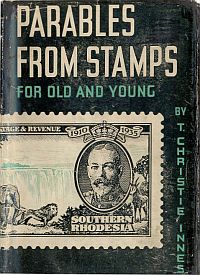 |
 |
I have mentioned elsewhere the pleasure to be gained from the absurd analogies sometimes employed in teaching the Bible. In this example of the art T C Innes, an earnest clergyman and enthusiast of philately, demonstrates a breathless, near hallucinatory, propensity to see the lessons of Jesus everywhere.
The pattern of his little sermons is a simple one: he looks at a stamp and is reminded by the picture shown on it of a sucession of loosely-connected anecdotes culminating in some message from the Gospels, in the process mixing and muddling his metaphors with an endearing lack of self-consciousness. For example, in a chapter called “The King of the Jungles”, he is inspired - by a stamp showing an image of a lion - to quote from the memoirs of the explorer Dan Crawford, first a passage in which the carcass of a dead lion is eaten by its hungry fellows, then another in which the canoes of the expedition meet a similar fate:
“In the far distance Mweru Lake was hoarsely threatening a storm, and the scudding clouds revealed a furtive moon. There, jammed into the thick, aquatic grass, lay our canoes for the morrow, the beach so tangled that we, for the night, were shut into a tight little skern to save our skins. At one in the morning, an ominous scrunching, and the famished lions are eating our canoes. Eating our canoes!”
This is followed by an account in which one of the native guides, “Shimpauka, one of the right sort”, has a terrible encounter with a wounded lioness in which, although she causes the loss of three of his fingers, the beast finally “owns up to the lordship of man - choked stone dead” .
Talking of lions brings to mind first King Richard I of England, known as Coeur-de-Lion, of whom Innes recounts an heroic though possibly apocryphal story of battle, then the Old Testament hero Othniel, the “Lion of God”. But:
... best of all, is the Great Crowned “Lion of the Tribe of Judah” - Jesus Christ our Lord.
One assumes that he does not mean to imply that Jesus is a cannibal, or that He'll crunch up your canoe. Such a notion might keep a young person awake at night.
Demonstrating a singular unworldliness, he begins another chapter thus:
The greatest lover the world has ever seen, was the Lord Jesus Christ ...
Innes has a remarkable capacity for tripping over his own metaphorical feet. For example, here's a section intended to lead us to “focus on Him”:
Focus means to deliberately exclude a thousand other interests. Life is packed and thronged with attractions arrayed on every hand to lure us to widen out as the Nile does at the delta - and it is necessary to remember one thing, the price! Widen out and you perish among the hot sands. If you focus in the true direction, you will not create, but you will possess new worlds.
(What would he have made of the Internet? As has often been observed, it also tends to lead to a widening out, particularly of the rear end.)
So far, Mweru Lake and the Nile have both made usefully educative appearances: the waters of Africa seem to fill his allegorical landscapes. Now here it is the turn of Victoria Falls, where he gets very excitedly anthropomorphic:
There it sings in reverberating bourdon tones, calling all nature to join in the great Hallelujah Chorus. And on our stamp the tall giraffe, the massive elephant, the regal lion, and the lithe springbok have each heard the giant's song, and have gathered round, to unite with the magnificent tropical trees that clap their hands in the chorus of adoration.
”Clap their hands”? Those are some unusual trees. If this sort of fevered passage is anything to go by, gazing at stamps and thinking about Jesus too much may make one slightly loose in the head. Perhaps that is the real message of this book: do take care not to fall into the same peril, dear reader.
Update: as this page reveals, the first edition of Parables from Stamps was removed from the general shelves of the British Library and placed in a restricted area alongside various other suppressed items. In this case I understand it was because of the presence of full colour, actual size reproductions of postage stamps, which breached Post Office regulations. I suspect the author was mortified when he found out that his innocent little book was sharing space with such items as "Punishment Posture For Girls".
The link in your last…
The link in your last paragraph is broken, try this one instead: http://scissors-and-paste.net/pdf/SS.pdf